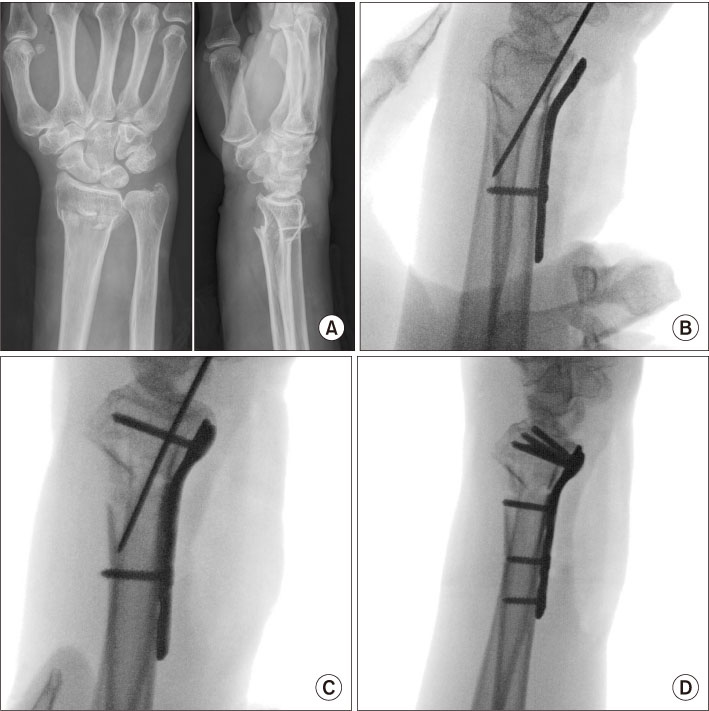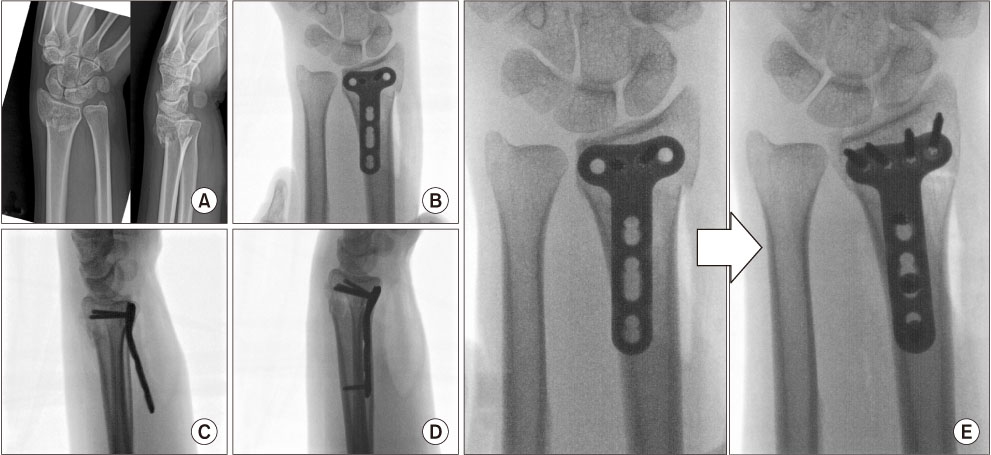Arch Hand Microsurg.
2019 Mar;24(1):24-31. 10.12790/ahm.2019.24.1.24.
The Effect of Volar Locking Plate Leveraging on Restoring Volar Tilt of Distal Radius Fractures
- Affiliations
-
- 1Department of Orthopedic Surgery, St. Vincent's Hospital, College of Medicine, The Catholic University of Korea, Suwon, Korea.
- 2Department of Orthopedic Surgery, St. Paul's Hospital, College of Medicine, The Catholic University of Korea, Seoul, Korea. jylos1@gmail.com
- 3Orthopedic Surgery, Hand and Microsurgery Department, Gyeongsang National University Changwon Hospital, Changwon, Korea.
- 4Department of Orthopedic Surgery, Yeouido St. Mary's Hospital, College of Medicine, The Catholic University of Korea, Seoul, Korea.
- KMID: 2440608
- DOI: http://doi.org/10.12790/ahm.2019.24.1.24
Abstract
- PURPOSE
The purpose of the study was to analyze the radiologic and clinical outcomes of volar locking plate leveraging technique comparing to conventional technique and to prove the effect of volar locking plate leveraging technique on restoring volar tilt of distal radius fractures.
METHODS
From January 2011 to December 2015, 196 patients (50 males and 146 females) who underwent operative treatment of distal radius fracture met the inclusion criteria and retrospectively analyzed. We defined group 1 (n=93, 23 males and 70 females) as patients who were operated by conventional method, and group 2 (n=103, 27 male and 76 females) as patients who were operated by volar locking plate leveraging technique. Postoperative radiographic parameters including radial inclination, radial length, and volar tilt were measured as radiologic outcomes and range of motion, pain visual analogue scale, grip strength, shortened disabilities of arm, shoulder and hand questionnaire were measured as clinical outcomes.
RESULTS
Postoperative radial inclination, radial length, and volar tilt in group 1 was 24.22°, 12.02 mm, and 9.31°, in group 2 was 25.64°, 12.40 mm, and 11.48°. There was statistically significant difference in postoperative volar tilt (p=0.008). There were no statistic differences in other radiologic parameters and clinical outcomes.
CONCLUSION
Volar locking plate leveraging technique is reliable and predictable technique for restoration of anatomical parameters of distal radius fracture, especially volar tilt.
Keyword
MeSH Terms
Figure
Reference
-
1. Nellans KW, Kowalski E, Chung KC. The epidemiology of distal radius fractures. Hand Clin. 2012; 28:113–125.
Article2. Kwon BC. External fixation for distal radius fractures. J Korean Soc Surg Hand. 2015; 20:85–88.
Article3. Ismail AA, Pye SR, Cockerill WC, et al. Incidence of limb fracture across Europe: results from the European Prospective Osteoporosis Study (EPOS). Osteoporos Int. 2002; 13:565–571.4. Chung KC, Spilson SV. The frequency and epidemiology of hand and forearm fractures in the United States. J Hand Surg Am. 2001; 26:908–915.
Article5. Thompson PW, Taylor J, Dawson A. The annual incidence and seasonal variation of fractures of the distal radius in men and women over 25 years in Dorset, UK. Injury. 2004; 35:462–466.
Article6. Hagino H, Yamamoto K, Ohshiro H, Nakamura T, Kishimoto H, Nose T. Changing incidence of hip, distal radius, and proximal humerus fractures in Tottori Prefecture, Japan. Bone. 1999; 24:265–270.
Article7. Chung KC, Shauver MJ, Birkmeyer JD. Trends in the United States in the treatment of distal radial fractures in the elderly. J Bone Joint Surg Am. 2009; 91:1868–1873.
Article8. Mattila VM, Huttunen TT, Sillanpää P, Niemi S, Pihlajamäki H, Kannus P. Significant change in the surgical treatment of distal radius fractures: a nationwide study between 1998 and 2008 in Finland. J Trauma. 2011; 71:939–942. discussion 942-3.
Article9. Nasser JS, Huetteman HE, Shauver MJ, Chung KC. Older patient preferences for internal fixation after a distal radius fracture: a qualitative study from the wrist and radius injury surgical trial. Plast Reconstr Surg. 2018; 142:34–41e.10. Dario P, Matteo G, Carolina C, et al. Is it really necessary to restore radial anatomic parameters after distal radius fractures? Injury. 2014; 45:Suppl 6. S21–S26.
Article11. Niver GE, Ilyas AM. Carpal tunnel syndrome after distal radius fracture. Orthop Clin North Am. 2012; 43:521–527.
Article12. Mignemi ME, Byram IR, Wolfe CC, et al. Radiographic outcomes of volar locked plating for distal radius fractures. J Hand Surg Am. 2013; 38:40–48.
Article13. Loveridge J, Ahearn N, Gee C, Pearson D, Sivaloganathan S, Bhatia R. Treatment of distal radial fractures with the DVR-A plate--the early Bristol experience. Hand Surg. 2013; 18:159–167.14. Koval K, Haidukewych GJ, Service B, Zirgibel BJ. Controversies in the management of distal radius fractures. J Am Acad Orthop Surg. 2014; 22:566–575.
Article15. Jakubietz MG, Gruenert JG, Jakubietz RG. Palmar and dorsal fixed-angle plates in AO C-type fractures of the distal radius: is there an advantage of palmar plates in the long term? J Orthop Surg Res. 2012; 7:8.
Article16. Kumbaraci M, Kucuk L, Karapinar L, Kurt C, Coskunol E. Retrospective comparison of external fixation versus volar locking plate in the treatment of unstable intra-articular distal radius fractures. Eur J Orthop Surg Traumatol. 2014; 24:173–178.
Article17. Wei DH, Raizman NM, Bottino CJ, Jobin CM, Strauch RJ, Rosenwasser MP. Unstable distal radial fractures treated with external fixation, a radial column plate, or a volar plate. A prospective randomized trial. J Bone Joint Surg Am. 2009; 91:1568–1577.18. Osada D, Viegas SF, Shah MA, Morris RP, Patterson RM. Comparison of different distal radius dorsal and volar fracture fixation plates: a biomechanical study. J Hand Surg Am. 2003; 28:94–104.
Article19. Chen NC, Jupiter JB. Management of distal radial fractures. J Bone Joint Surg Am. 2007; 89:2051–2062.
Article20. Porter M, Stockley I. Fractures of the distal radius. Intermediate and end results in relation to radiologic parameters. Clin Orthop Relat Res. 1987; 241–252.21. Park MJ, Cooney WP 3rd, Hahn ME, Looi KP, An KN. The effects of dorsally angulated distal radius fractures on carpal kinematics. J Hand Surg Am. 2002; 27:223–232.
Article22. McLawhorn AS, Cody EA, Kitay A, Goldwyn EM, Golant A, Quach T. Leveraging the plate: reliably restoring volar tilt of distal radius fractures. Orthopedics. 2013; 36:918–921.
Article23. Roebke AJ, Martin AS, Sarmast Z, Fisk E, Goyal KS. Lift-Off screw results in accurate sagittal tilt correction in a distal radius fracture model. J Hand Surg Am. 2018; 43:523–528.
Article24. Park JW, Kim YH, Park KC, Lee JI. A novel technique for full anatomic restoration of volar tilt in distal radius fracture. Acta Orthop Traumatol Turc. 2015; 49:115–119.
Article
- Full Text Links
- Actions
-
Cited
- CITED
-
- Close
- Share
- Similar articles
-
- Failure of Distal Locking Screws in an Intraarticular Distal Radius Fracture Treated with Volar Locking Plate Fixation
- Comparison of Operative Management in Distal Radius Fractures Using 3.5 mm Versus 2.4 mm Volar Locking Compression Plates
- Treatment of Fractures of the Distal Radius Using Variable-Angle Volar Locking Plate
- Comparative Analysis of the Results of Fixed-angle versus Variable-angle Volar Locking Plate for Distal Radius Fracture Fixation
- Volar Plating of Distal Radius Fractures



